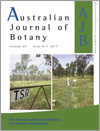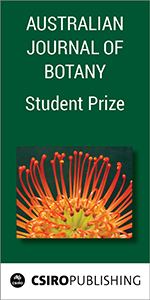Australian Journal of Botany
Volume 65
Numbers 6 & 7 2017
Understorey is a key component of a forest ecosystem. Forest thinning may change the structure, diversity and cover of the understorey by reducing tree density and increasing gaps in the forest canopy. To achieve the highest richness, evenness and cover, a combination of selective thinning intensity and residue removal rate were suggested by applying a central composite design.
This work reports on the occurrence of natural hybridisation between three sympatric orchid species. The reproduction of the species was recorded based on morpho-anatomical, histochemical analyses and intra- and interspecific crosses. The relationship between co-occurring species was verified by floral morphometry and principal component analysis, and sequence divergence analyses. All data collected suggest that no gene flow is currently occurring, and that hybridisation has been avoided due to the incompatible pollinarium size between the sympatric species, which acts as a pre-mating barrier in the studied population.
Travelling stock reserves (TSRs) are critically important for the conservation of temperate woodland communities that have otherwise been extensively cleared and degraded for agriculture. We compared the vegetation attributes of TSRs with remnants managed for agricultural production and found the former supported higher native plant species richness, more native ground cover and fewer exotic plants. Our results indicate that land tenure status of remnant woodlands generally influenced several vegetation attributes that are also important for native biodiversity.
Eucalyptus delegatensis R.T. Baker subsp. delegatensis is an interval-sensitive, fire-killed eucalypt found in the Australian Alps. Flowering and fruiting in stands of saplings regenerating after the 2003 fires is occurring much earlier than previously thought. Seed from such early maturing alpine is viable, with a mean of 455 (s.d. = 139) germinants per 10 g of chaff and seed mix.
Nitrogen is an essential nutrient for plant metabolic processes, so nutritional conditions can affect leaves and plant survival. A study of the effects of N on the foliar morphoanatomy of Anacardium othonianum showed that absence and excess of this nutrient affect leaf structure, as well as the synthesis of compounds of the metabolism. This work contributes to biological knowledge this species and to the growth of healthier seedlings.
Flowers and inflorescences are extremely diverse and some of them show structures that are difficult to interpret, which led us to ask: how are these flowers built? Inside the family of castor beans, Euphorbiaceae, a large group, Croton, shows small flowers containing some structures that are alternatively considered as petals, glands or simple filaments. Studying the development of these flowers reveals the origin of the floral parts and their real identity, taking us closer to decipher flower diversity.’
The anatomical study of the bromeliad Nidularium minutum Mez roots showed the occurrence of a multiseriate epidermis, termed velamen. The root system was as efficient as the tank for nutrients uptake, contributing to plant growth and development, most likely assisted by the presence of velamen.
The evolutionary significance of wood anatomical characters of the Australian legume tribes Bossiaeeae and Mirbelieae is explored for the first time. Short vessel elements and the unique presence of tanniniferous tubes support the idea of a relationship with the South African tribe Hypocalypteae. The results highlight another interesting connection between the Australian and South African floras.
Plants of Sarcocornia fruticosa were subjected to five saline treatments (10 (control), 60, 100, 200 and 300 mM NaCl) over a period of 60 days. The results of this experiment showed that S. fruticosa can maintain its major physiological processes at 60 mM NaCl without significant dry weight reduction.
Ecological interactions between plants and insect herbivores in Australian high mountains remain largely unexplored. We quantify the effects of herbivores on snow gum saplings near the alpine treeline and show that leaf loss is a function of elevation, plant height and traits such as leaf thickness.
To control or to favour populations of Acacia melanoxylon it is necessary to know its germinative strategy. Our work shows that fire can greatly affect the amount of seeds of A. melanoxylon germinated and that the age of mother plants influences the time in which the germination occurs after fire. These results have important implications for the management of this species whatever its purpose – either the implementation of control measures or ecological restoration.




